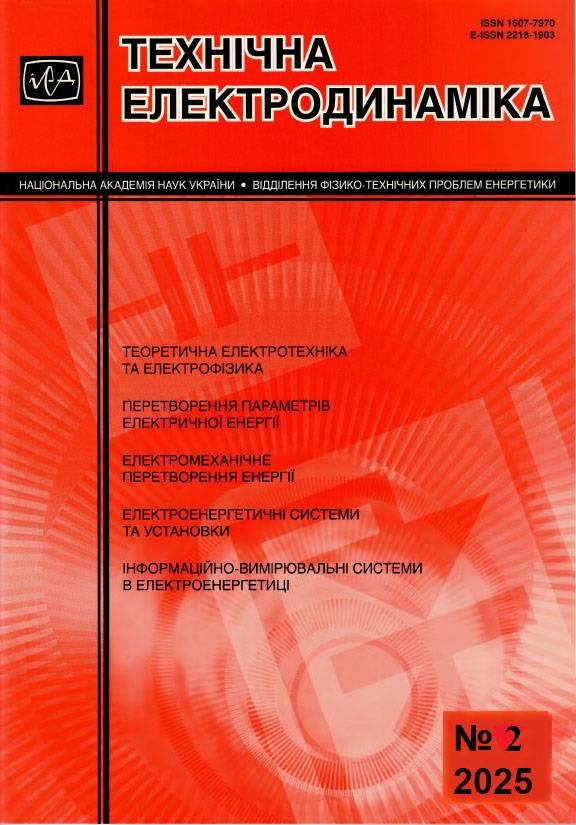Abstract
The work is devoted to the use of matrix theory to represent the topology of electric circuits in photovoltaic panels and photovoltaic power stations and their modeling and calculation. When creating the electric circuits in photovoltaic devices, the controlled connections between photovoltaic cells in photovoltaic panels or photovoltaic panels in photovoltaic power stations are used. The advantages of using the dynamic controlled connections instead of fixed ones are noted. The expediency of using the field-effect transistors as a switching element is mentioned. The incidence matrices with elements responsible for series connection, parallel connection and shunt connection are created. That is, by selecting the elements of the matrix, the corresponding connection is implemented. It is noted that these elements can be parametric and change in time that leads to the implementation of a dynamic system. It is shown that using a matrix presentation it is also convenient to calculate the cascade connections of photovoltaic cells or photovoltaic panels, for which the input values are the output values calculated for the previous cascade. It is also shown that it is convenient to separate a unified calculation matrix to a generation matrix, a matrix of parametric processes and a matrix of connections. It is noted that the use of matrix analysis to the calculation of electric circuits allows the use of algorithms for model computer creation and computer simulation. The conclusions were made and it was shown that it is advisable to develop a matrix approach for use in the calculation of hybrid energy systems. References 23, figures 3.
References
Kudria S.О., Mhitarian N.М., Reztsov V.F. Vidnovluvani dzherela energii. Kyiv: Interservice, 2020. 392 p. (Ukr)
Matyakh S., Rieztsov V., Surzhyk Т. Complex solutions in solar energy. Vidnovliuvana energetyka. 2022. No 3. Pp. 68-74. DOI: https://doi.org/10.36296/1819-8058.2022.3(70).68-74. (Ukr)
Bondarenko D. Dynamic connection pv-cells in solar panels. Vidnovliuvana enerhetyka. 2021. No 3. Pp. 45-51. DOI: https://doi.org/10.36296/1819-8058.2021.3(66).45-51. (Ukr)
Gontijo G., Soares M., Tricarico T., Dias R., Aredes M., Guerrero J. Direct Matrix Converter Topologies with Model Predictive Current Control Applied as Power Interfaces in AC, DC, and Hybrid Microgrids in Islanded and Grid-Connected Modes. Energies. 2019. No 12. P. 3302. DOI: https://doi.org/10.3390/en12173302.
Meshchaninov O. Simulation of systems. Mykolaiv: MF NaUKMA, 2001. 268 p.
Ajay Kumar, Nitin Gupta, Vikas Gupta. A comprehensive review on grid-tied solar photovoltaic system. Jornal of green engineering. 2007. No 7(1). Pp. 213-254. DOI: https://doi.org/10.13052/jge1904-4720.71210.
Vaishnavi P. Deshpande, Sanjay B. Bodkhe. Photovoltaic Module Interconnection Modified to Improve Efficiency & Robustness. International Journal of Applied Engineering Research. 2017. Vol. 12. No 24. Pp. .15560-15563.
Velasco-Quesada G., Guinjoan F., Pique-Lopez R., Roman-Lumbreras M., Conesa-Roca A. Electrical PV array reconfiguration strategy for energy extraction improvement in grid-connected pv systems. IEEE Transaction on Industrial Electronics. 2009. Vol. 56. No 11. Pp. 4319-4331. DOI: https://doi.org/10.1109/TIE.2009.2024664
Qi J., Huang X., Ye B., Zhou D. PV Array Reconfiguration Based on the Shaded Cells' Number for PV Modules. CSEE Journal of Power and Energy Systems. 2023. No 9(2). Pp. 733-742. DOI: https://doi.org/10.17775/CSEEJPES.2020.06140.
Jeong W., Kim H. Optimum Connection Structure for Photovoltaic Array Considering Shadow Influence. IEEE PES Asia-Pacific Power and Energy Engineering Conference (APPEEC), Macao, China, 01-04 December 2019. Pp. 1-6. DOI: https://doi.org/10.1109/APPEEC45492.2019.8994480.
Tabanjat A., Becherif M., Hissel D. Reconfiguration solution for shaded PV panels using switching control. Renewable Energy. 2015. Vol. 82. Pp. 4-13. DOI: https://doi.org/10.1016/j.renene.2014.09.041.
Bondarenko D. Using MOSFET-transistors in solar panels. Vidnovliuvana energetyka. 2022. No.3, pp.62-67. DOI: https://doi.org/10.36296/1819-8058.2022.3(70).62-67.(Ukr)
MOSFET. Wikipedia. 2024. URL: https://en.wikipedia.org/wiki/MOSFET (accessed at 30.07.2024).
Bondarenko D. Optimal topology of electric circuits in pv-panels and pv-plants with using controlled connections. Vidnovliuvana energetyka. 2024. No 1. Pp. 57-61. DOI: https://doi.org/10.36296/1819-8058.2024.1(76).57-61.
Wang X.-F. Modern Power Systems Analysis. Springer, 2008. 561 p. DOI: https://doi.org/10.1007/978-0-387-72853-7
Aimee Kalnoskas. A simple and inexpensive ideal-diode MOSFET circuit. Power electronic tips. 2017. URL: https://www.powerelectronictips.com/inexpensive-ideal-diode-mosfet-circuit/ (accessed 25.07.2024).
Joshua Israelson. What is the MOSFET body diode? URL: https://www.powerelectronictips.com/remember-mosfet-body-diode-faq/ (accessed at 26.07.2024).
Data and specifications of IRF8313PBF. URL: https://www.infineon.com/cms/en/product/power/mosfet/n-channel/irf8313/ (accessed at 26.07.2024)
Chua L., Lin Pen-Min. Computer-aided analysis of electronic circuits. NJ: Prentice-Hall, Inc, 1975. 737p.
Natarajan R. Computer-Aided Power System Analysis. CRC Press, 2002. 392 p. DOI: https://doi.org/10.1201/9780203910832
Arrillaga J. Computer Analysis of Power Systems. John Wiley & Sons, 1990. 376 p. DOI: https://doi.org/10.1002/9781118878309
Grigsby L. Power Systems. CRC Press, 2012. 556 p.
Bondarenko D. Combination of PVT-collectors with using of controlled connections. Vidnovliuvana energetyka. 2024. No 2. Pp. 86-91. DOI: https://doi.org/10.36296/1819-8058.2024.2(77).86-91.

This work is licensed under a Creative Commons Attribution-NonCommercial-NoDerivatives 4.0 International License.
Copyright (c) 2025 Tekhnichna Elektrodynamika


